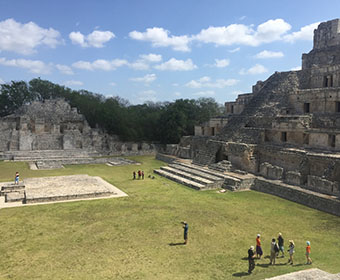Course allows UTSA students to explore ancient Maya sites

(March 7, 2017) -- In anticipation of a trip to the Yucatan during spring break, UTSA students are learning about 19th-century explorers.
The course "Footsteps of the early Maya explorers", co-taught by anthropology professor Kathryn Brown and art history professor Juliet Wiersema, brings together 15 undergraduate and 7 graduate students who are eager to learn about the ancient Maya.
This semester, the students learned about Mayan architecture, art, history and ancient sites. The course also traces the steps of nineteenth-century explorers like John L. Stephens and Frederick Catherwood in Mexico and Central America.
"Students learn about intrepid explorers in the mid-19th century who, despite great risks like malaria, dehydration and starvation, paved the way for modern archaeologists, art historians and epigraphers," said Wiersema.
"The part I find most fascinating about the course is learning all the different biases and theories many of these early explorers had. The early artwork, which is supposed to be an exact representation of the sites, is anything but that. There are clear exaggerations in many cases," said Carlos Mendez, a UTSA senior studying art history and criticism.
As part of the UTSA course, students will travel to the Yucatan on March 12 to experience the Maya sites and cities they are studying.
"Through this interdisciplinary course and half and full-day trips, the students will understand the complexity of Maya palaces, temples and artwork and gain an appreciation for the Maya's technological, intellectual and artistic achievements," said Brown.
The weeklong trip begins and concludes in Merida. From Merida, the group will visit sites such as Chichen Itza, Mayapan, Dzibilchaltun and take day trips to places such as Kiuic, Labna, Uxmal, Sayil and Kabah.
At the "observatory" at Chichen Itza, students will learn about the astronomical sophistication of these pre-Hispanic cultures. During their visit to Uxmal, a site described by early explorers Stephens and Catherwood, students will compare the experience of a nineteenth-century explorers to their own.
"These site visits offer students a chance to feel like explorers themselves," said Wiersema.
Graduate and undergraduate students were able to collaborate on research projects during the course. Graduate and undergraduates will lead site tours during the trip based on what they have learned about the different sites.
"As an archaeologist, it is important to learn about and be aware of the diversity of past material culture in the region I study. By going on this trip, I will get to experience this diversity of the Maya firsthand," said Rebecca Friedel, doctoral candidate in the UTSA Department of Anthropology.
"We are so excited about this program and hope that our students come away with new and different ways of viewing the ancient Maya civilization," said Brown.
-------------------------------
Learn more about the UTSA College of Liberal and Fine Arts.
Learn more about the UTSA Department of Anthropology.
Learn more about the UTSA Department of Art and Art History.
Connect with UTSA online at Facebook, Twitter, YouTube, Instagram and LinkedIn.
Events
Move In To COLFA is strongly recommended for new students in COLFA. It gives you the chance to learn about the Student Success Center, campus resources and meet new friends!
Academic Classroom: Lecture Hall (MH 2.01.10,) McKinney Humanities BldgWe invite you to join us for Birds Up! Downtown, an exciting welcome back event designed to connect students with the different departments at the Downtown Campus. Students will have the opportunity to learn about some of the departments on campus, gain access to different resources, and collect some giveaways!
Bill Miller PlazaCome and celebrate this year's homecoming at the Downtown Campus with food, games, giveaways, music, and more. We look forward to seeing your Roadrunner Spirit!
Bill Miller Plaza

